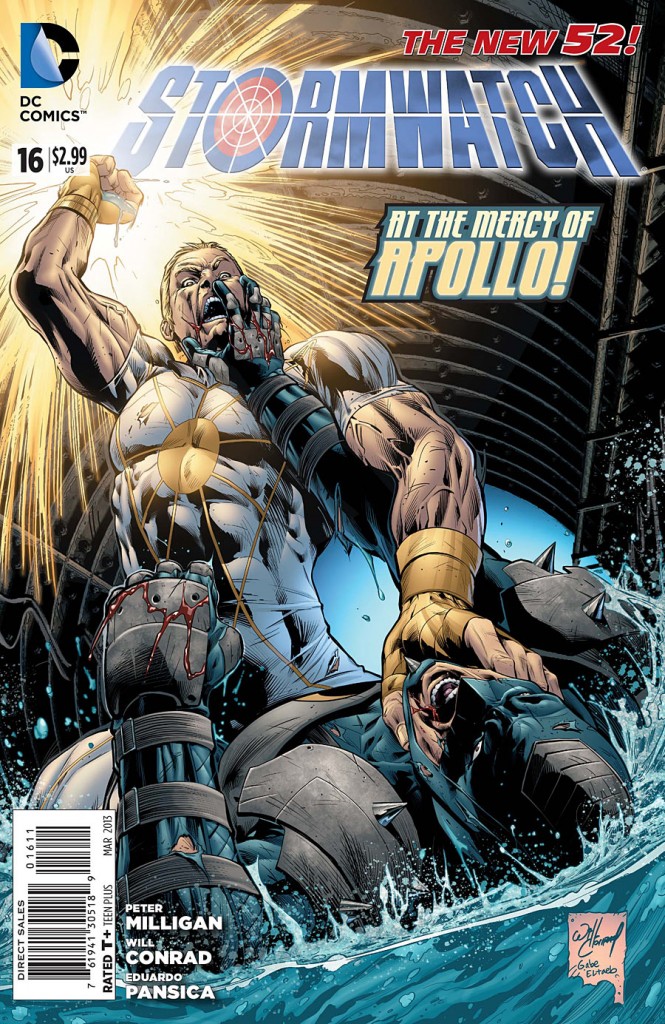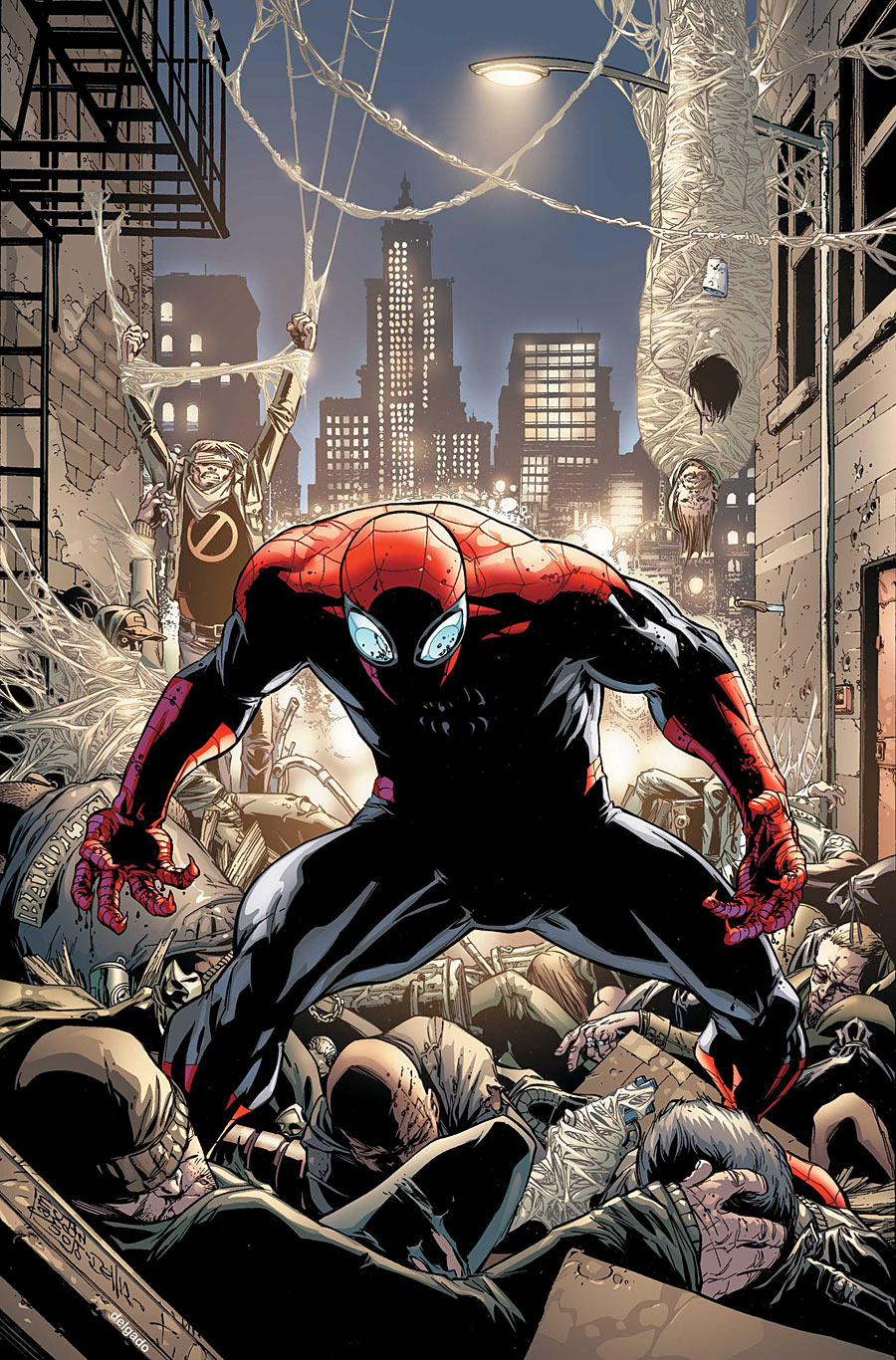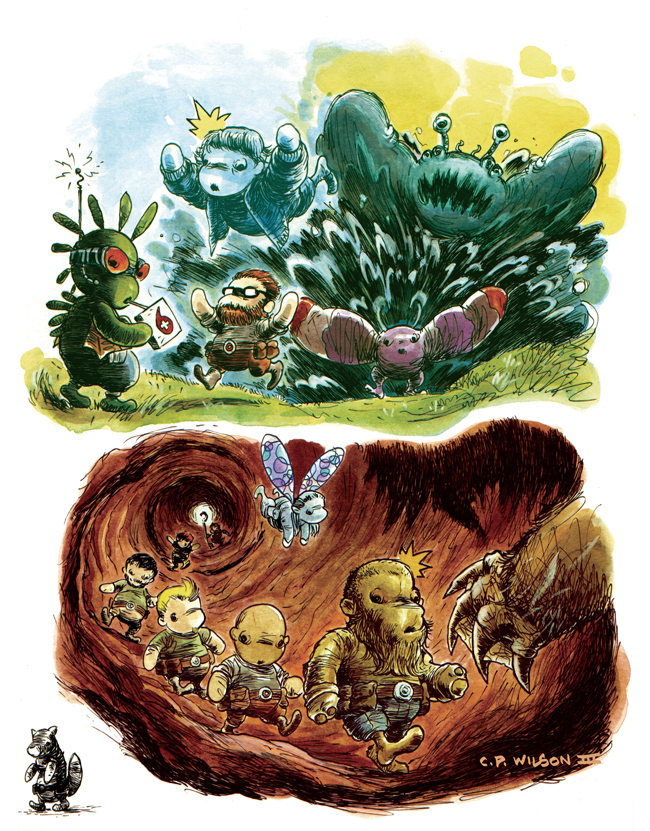Aside from being Dennis Hopeless week once more, this week saw every company release a massively publicized, ‘important’ comic. From Dark Horse’s new Star Wars series to Marvel’s Sinister Spider-Man, this was a week for big new books.
But whilst they all look good (and I’ll be offering a brief thought on Sinister Spider-Man later), I was distracted from everything else on the shelf by C.P. Wilson III’s cover for The Perhapanauts. I had no knowledge of the book or creative team, but the cover was so interesting to look at that I HAD to pick it up. That’s the importance of a good cover, guys!
On a similar note, The End Times of Bram and Ben also had an excellent cover from Jim Mahfood, with a really fun story inside it too. Covers, you guys! We need to emphasise just how important it is to make your cover interesting — and that doesn’t just mean big font and people with swords. Character and quirky charm will get you everywhere.
This week I’ll be reviewing Ghost #3, Stormwatch #16, Sinister Spider-Man #1 (briefly!) and The Perhapanauts #3.
This was my first issue of Ghost, a relaunch of the spectral hero from Dark Horse. I believe so far the creative team of Kelly Sue DeConnick and Phil Noto have put out three other issues, and it’s interesting to jump in at this point in their collaboration. Although a series about the eponymous hero, this issue is mostly focused on other characters, from what I can tell. There are three sequences, with Ghost only appearing in the second of them, and the other two setting up a villain and… something else? It was difficult to know. It’s my fault for not jumping on from the start, but there was a slight loss of clarity towards the end of this issue.
That’s not as a result of DeConnick’s writing, which crafts a very well realised world for the characters to inhabit, and stretches the cast apart very effectively. It’s not uncommon for a book like this – a solo ‘hero’ title – to lose the reader’s interest whenever the main character isn’t on the page. Dexter syndrome. But here DeConnick makes sure that the rest of the cast are fleshed out even when separated and spending time with peripheral figures such as – in this instance – a villain. I think if there are any problems to be had with clarity in the issue, they likely come about as a result of Noto’s artwork.
Which is lovely, don’t get me wrong. Phil Noto has a knack for expression which absolutely nails the mood every single time. However, he also doesn’t differentiate female faces particularly well in this issue, and uses absolutely gigantic gutters between the panels. This gives an almost clinical look to the book, and a rigid sense of structure which doesn’t suit a book about the uncanny. It does seem that he is using these clear, empty gutters as a way to establish a very straightforward look for the comic which then collapses when something supernatural and creepy happens – however, in the sequence where this happens this issue, that impact doesn’t work. If the book is set out so simplistically because it’s meant to contrast with the supernatural scenes which don’t have gutters, then the technique simply doesn’t work. It feels silly.
Ghost is a step above similar titles, but there are some artistic choices made here which don’t work, and that’s a shame. The colouring from Lee Loughridge attempts the same trick, albeit with a lucid watercolour effect on every page apart from the standout supernatural moments – which are brightly coloured, to the point of almost seeming neon. Rather than providing a bold statement of intent, however, this also tends to make the pages look cartoonish and garish, rather than shocking and bold. In my opinion, while the art and colouring are both solid, they both also make some structural decisions which weaken the story, rather than strengthen it.
Stormwatch #16 was similarly halfway through a storyline when I jumped in, it appears, although this was rather harder to piece together. I’m surprised that so few companies actually run ‘previously on’ pages, because it’d certainly make my life easier. Then again, I’m a demographic of one person, so perhaps fair enough, companies. This issue concludes the ‘traitor’ storyline which has been running for a few issues now, with the traitor himself revealed.
Writer Peter Milligan manages to twist that reveal a few times, rather nicely, although to do so he does have to jam in some very convenient moments which aren’t exactly subtle. It’s been a bit frustrating reading Milligan on the book, because while he’s done some solid work with the characters and the idea of the team, his stories have been haywire and prone to collapsing under themselves. This issue is a great case in point really, with the characters making interesting decisions and doing surprising things despite the dull and incoherent plotline they’re following. Will Conrad – whose work always reminds me of Mike Deodato Jr, although with more focus on clarity than style – does a good job keeping things together, although Rob Leigh’s lettering throws out helping hands to help keep the reader on track.
This is a book which would certainly seem to fit Milligan’s style of writing, but so far that potential for good stories has been drowned out by decent – yet far from spectacular – plotting.
Dan Slott and Ryan Stegman have played a blinding hand with the readers for Superior Spider-Man, somehow managing to make a massive deal out of what would be a fairly standard storyline back in the 70s. That they were allowed to reboot the book at the end made for great publicity, as Slott gleefully wound up the fans to a point where they became incoherent juddering masses of outrage. The comic itself keeps up the standard held by his run on Amazing, albeit with a few different points to note.
One is that the new voice inside Peter Parker isn’t as strong as it was before. That’s not a knock on Slott – it’s just that Otto is primarily a villainous character, and has nowhere near the depth of personality that Peter Parker received over the years. He’s always been more of a generic mad scientist than a deeply-felt character, and that does hurt this comic somewhat. Stegman compensates magnificently by giving the character an incredibly silly sense of posture and movement, with a charmless sense of smug grandeur in his every movements. You can body swap the mad scientist into the spider, but you can’t body swap the mad scientist out the spider! Stegman does some brilliantly fun, wazzy (first time anybody’s ever used that word in a review, right? Welcome to a world where Yorkshireman are allowed on The Beat, people) visuals, and particularly excels in the fight scenes. It’s fast paced and kinetic in a way which could only be matched by Eric Canete or Humberto Ramos, but in a style all Stegman’s own.
The second thing I’d note is that this book has a surprising amount of murder mystery in it, although this time we’re watching the various characters try and work out what’s going on. That’s an interesting hook, which is good because I’m not certain Otto Octavius alone would be able to sustain a year by himself.
But anyway – go read Hannah’s SUPERIOR (snigger) review if you want more on Spidey.
That’s the cover which made me pick up Perhapanauts! Which is a ragtag bunch of silly characters going off on missions and adventures, and appears to actually be an all-ages title from Image! That rarest and most delightful of things.
Inside the issue are three stories, all written by Todd Dezago, with the main story drawn by co-creator Craig Rousseau. The other two backups are from Matthew Dow Smith and Matt Weiringo respectively, and are actually the highlights of the book. After going through the book and finishing on the high note of Dezago/Weiringo’s wild west story, I’d recommend going back with your newfound appreciation for some of the characters and applying it to the main story. It reads far better once you have a grasp on who some of these characters are.
Again though – that’s my fault for jumping on with issue #3. This is a fun book, without much story but a lot of different characters. Most of the entertainment comes from seeing them bounce off each other, with the plot just a distraction and means by which to force them all into cramped circumstances. The pacing is a little off – but becomes clearer with a re-read – and there are a few jokes which don’t land. There is a flying pixie woman though, and you can’t go wrong with them. I feel like perhaps the characters are better geared towards short stories than ongoing narratives, because this story is very slight, and even then feels like it’s pulling time away from the characters.
Rousseau’s artwork is okay. I think it drastically improves once the story moves into a subterranean setting, and more shading can be used. However, his fight sequences don’t tell a story and it’s difficult to know what’s happening. There’s a difficult sense of perspective here, in that it’s hard to keep track on where the characters are standing in relation to each other. None of these distract too much from the story, but it does need work.
Perhapanauts is a fun little read. It’s lightweight but entertaining, with some nicely designed characters. The book definitely picks up when telling shorter, self-contained stories though. The main story feels a little drawn out and limp.












Comments are closed.